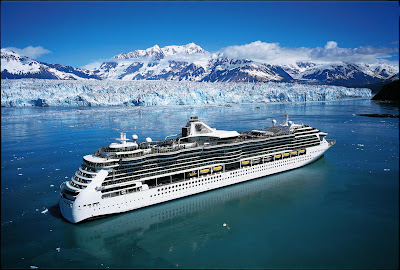Destination Alaska
Destination Alaska
The seven kayers following the Savonoski Loop in katmai National Park were settled in for the evening, sipping mugs of hot tea, when across the Grosvenor River a brown bear appeard. It was a young male, maybe 200lb, 300lb, 300lb tops. He followed the bank for s a short spell and then splashed across the river and came within 30yd of their four Kleppers, folding kayaks composed of a light wooden frame and a rubberized canvas hull that a brown bear, even a small one, could mangle in minutes. The kayakers stood in unison, grabbed pots and pans and banged them while chanting 'hey, bear whoa bear!' For a brief moment everybody stared nervously at each other, acknowledging the other's existence, then the young bear decided that whatever the kaykers were selling, he didn't and scrambled off into the woods.
Alaska is where human beings stand on equal footing with nature. Nowhere else in the U.S.A is there such undeveloped, unpopulated and untrampled place.
Tourists who make the long journey north solely to discover the unspoiled character of this 'final frontier' are still often stunned by the grandeur of what they see. There are mountains, glaciers and rivers in other parts of North America, but few are on the same scale as those in Alaska. This state as the third longest river in the U.S.A, 17 of the country's 20 highest peaks and 5000 glaciers, including one larger than Switzerland. The Arctic winters are one long night and Arctic summers on long day. In Alaska, there are King crabs that measure 3ft from claw to claw, brown bears that stand over 12 ft tall, farmers who grow 90lb cabbages and glaciers that discharge icebergs the size of small houses.
In other states protests are staged to save a wetland or a woodlot or a park .In Alaska the battleground is an entire ecosystem. At almost 20 million acres, trhe Arctic National Wildlife Refuge (ANWR) is the size of the South Carolina, encompassing 18 major rivers and the greatest variety of plant and animal life including 36 species of land mamals- of any conservation area in the circumpolar north.
The battle over drilling for oil in ANWR has been raging since the 1980's but has intensified with the recent price surge at the pump. With gas breaking $4 gallon at one point in 2008, the ANWR again took centre stage as one of the most contentious issues hovering over Alaska. The question of drilling not only pits environmentalists again free-market conservatives but Alaskans against Outsiders and even Native tribes against eachother. The sudden rise in the price of other resources- copper,gold,zinc and silver to name but a few- has had a similar effect,with a marked increse of mining projects around the state delving into nature in an effort to retrieve what is needed elsewhere.
Many Alaskans moved here, or simply stayed here a tthe end of their trip, because of Alaska's overhelming beauty. But in choosing to reside here they have to make a living in a place where there is little farming and even less industrial manufactoring. Hovering near 7% Alaska's unemployment rate is one of the highest in the country. This is why the vast majority of Alaskans are in favor of opening the. ANWR to the oil industry and building a natural gas pipeline across the state, running, south from the vast deposites in the North Slope. Both schemes represent jobs, an economic boom,and a new source of revenue in a place where oil royalties account for more than 80%of the state treasury.
Getting started
You can't see all of Alaska in a summer and you can't plan an Alaskan trip in a week. This is no quickie getaway. For most travellers the 49th state is a big
land that's far away. It's size means visitors need to focus on the regions that interest them the most, while its short, but busy, summer season almost
demands advance planning. The less time and the tighter the budget you have, the more you'll want to plan the trip and have reservations in a place
when you arrive. It's easy to travel in Alaska but not at the last minute.
When to go
The traditional season for heading to Alaska is June through Augost when the weather is at its best, the days are long and everybody - tourists and locals
alike - are outside playing. Summers in Alaska are a beatiful mixture of long days and short nights, climaxing on summer solstice (june 21) when Anchorage
enjoys more than 19 hours of sunlight and Fairbanks almost 22 hours. Along with the sunshine, the average summer tempratures in the Interior range
from 55°F to 75ºF, with a brief period in July to August when they top 80ºF or even 90ºF.Anchorage averages 60ºF to 70ºF in the summer while the southeast and Prince William Sound are coller and wetter. The Bush, north of the Arctic Circle, is
cool for most of the summer, with temperatures around 45ºF.
Activities


















No comments:
Post a Comment